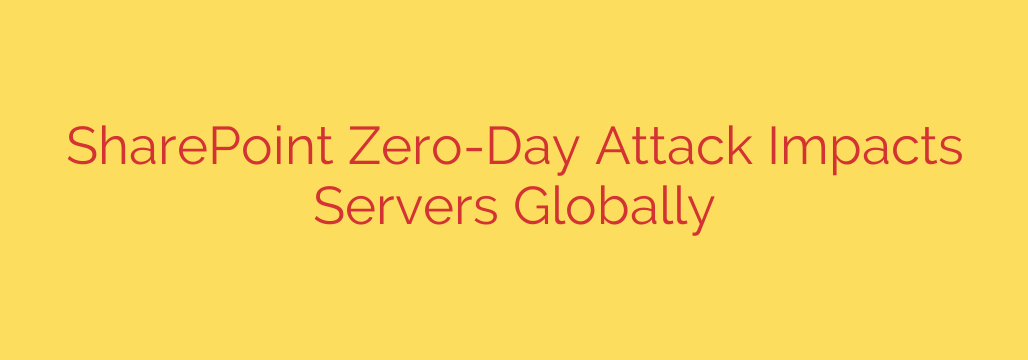
Critical SharePoint Zero-Day Vulnerability Allows Remote Code Execution
A newly discovered and actively exploited zero-day vulnerability is impacting Microsoft SharePoint Servers, creating a significant security risk for organizations globally. This critical flaw allows unauthenticated attackers to achieve remote code execution (RCE) on vulnerable servers, a worst-case scenario that could lead to a full system compromise.
Because this is a zero-day attack, it means threat actors were exploiting the vulnerability before an official patch was available, leaving many systems exposed. If your organization uses an on-premises SharePoint Server, immediate action is required to assess your risk and apply necessary mitigations.
Understanding the Threat: The RCE Vulnerability
The vulnerability stems from a flaw in how SharePoint processes specific web requests. By sending a specially crafted, malicious request to a target server, an attacker can execute arbitrary code with the privileges of the SharePoint application pool.
Here’s why this is so dangerous:
- No Authentication Required: The attacker does not need valid user credentials to launch the attack. This makes any internet-facing SharePoint server a potential target.
- Full Server Control: Remote Code Execution (RCE) essentially gives an attacker a backdoor into your server. They can install malware, exfiltrate sensitive data, create new administrator accounts, or use the compromised server to launch further attacks on your internal network.
- Active Exploitation: This isn’t a theoretical threat. Security researchers have confirmed that threat actors are actively scanning the internet for vulnerable servers and exploiting this flaw in the wild.
This vulnerability primarily affects on-premises installations. SharePoint Online (part of Microsoft 365) is not believed to be affected, as Microsoft manages the security and patching for its cloud infrastructure.
Which SharePoint Servers Are at Risk?
The vulnerability has been confirmed to impact several versions of the platform. Your systems may be at risk if you are running:
- Microsoft SharePoint Server 2019
- Microsoft SharePoint Server 2016
- Microsoft SharePoint Server Subscription Edition
Older, unsupported versions of SharePoint may also be vulnerable and present an even greater risk due to the lack of ongoing security support.
Urgent Mitigation Steps: How to Protect Your Servers Now
With an official patch potentially still in development, waiting is not an option. Your security and IT teams must take proactive steps immediately.
1. Scrutinize Server Logs for Suspicious Activity
Your first step is to hunt for indicators of compromise (IoCs). Check your SharePoint ULS logs, IIS logs, and Windows Event Logs for unusual patterns, such as:
- Anomalous
w3wp.exeprocess behavior, especially if it spawns processes likecmd.exeorpowershell.exe. - Unexpected outbound network connections from your SharePoint server to unknown IP addresses.
- The appearance of strange files (e.g., .aspx, .php, or .jsp files) in web-accessible directories.
2. Restrict Access to Your SharePoint Server
If your SharePoint server is currently accessible from the public internet, consider immediately restricting access until you can confirm it is secure. If external access is a business necessity, ensure it is placed behind a robust Web Application Firewall (WAF) with updated security rules designed to block anomalous requests.
3. Apply Temporary Fixes
While awaiting an official patch from Microsoft, temporary mitigation scripts or configuration changes may be recommended by security experts. These often involve using tools like the URL Rewrite module in IIS to block the specific malicious request patterns being used in the attack. Monitor official channels and trusted cybersecurity sources for guidance on these temporary measures.
4. Prepare for Patch Deployment
Ensure your team is ready to deploy the official security patch as soon as it becomes available. This includes having a tested patching process and a plan to schedule a maintenance window for this critical update.
Long-Term SharePoint Security Best Practices
This incident is a stark reminder of the importance of a defense-in-depth security strategy. Beyond addressing this immediate threat, organizations should recommit to these essential security practices:
- Consistent Patch Management: Regularly apply all security updates for SharePoint, Windows Server, SQL Server, and all related software.
- Principle of Least Privilege: Run SharePoint service accounts with the minimum necessary permissions. Never use domain administrator accounts for SharePoint services.
- Network Segmentation: Isolate your SharePoint farm from other parts of the network to contain the potential blast radius of a compromise.
- Regular Security Audits: Proactively audit your SharePoint environment for misconfigurations, excessive permissions, and signs of unauthorized activity.
The key takeaway is that this SharePoint vulnerability represents a clear and present danger. By taking swift, decisive action to investigate your systems, apply mitigations, and prepare for patching, you can significantly reduce your organization’s risk of a serious data breach.
Source: https://heimdalsecurity.com/blog/sharepoint-zero-day-vulnerability/








